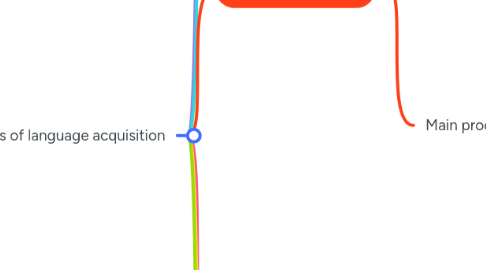
1. Theories of language acquisition
1.1. Behaviourism
1.1.1. A theory of learning that focuses on observable behaviours instead of internal mental processes. It proposes that behaviours and knwoledge are acquired through interaction with others.
1.1.1.1. B.F. Skinner
1.1.1.1.1. American psychologist, author, social philosopher and behaviourist who is well known for his development of the operant condition theory.
1.1.1.1.2. He explicitly rejects the idea of
1.2. Innatism/Generativism
1.2.1. Theory that proposes that some structures of knowledge, in particular language, are innate in the human mind and not learned completely from experience. It says that humans are born with a cognitive framework that enables them to acquire language with not much external input, as well as it suggests that universal principles of thought and grammar are biologically hardwired.
1.2.1.1. Noam Chomsky
1.2.1.1.1. American linguist, cognitive scientist, philosopher, and political activist. He is best known for revolutionizing the study of language through his theory of Generative Grammar, which argues that language ability is innate and not just learned from experience.
1.2.2. Involves
1.2.2.1. Innate structures
1.2.2.1.1. Inborn cognitive frameworks or mechanisms that enable learning, especially in areas like language and reasoning. These structures are believed to be present at birth rather than acquired through experience.
1.2.2.2. Input
1.2.2.2.1. The language that a learner is exposed to in order to acquire a language. This can be written or spoken, and can come from a variety of external sources.
1.2.2.3. Children
1.3. Social interactionism
1.3.1. A theory of language acquisition that emphasizes the role of social interaction in the development of language. According to this theory, children acquire language through their interactions with caregivers, peers, and the social environment rather than being driven only by an innate language mechanism or structure. In this theory, language is a social tool used for communication, and it is learned through meaningful exchanges between individuals.
1.3.1.1. Lev Vygotsky
1.3.1.1.1. Russian psychologist and a prominent figure in the field of educational psychology and cognitive development. His work has had a significant influence on understanding how language and thought develop, particularly in the context of social interaction and cultural influences.
1.3.1.1.2. Proposed
1.3.2. Social interaction
1.3.2.1. The way people behave with each other, using language and other forms of communication. It's a key part of learning language and developing communication skills.
1.3.3. Main processes
1.3.3.1. Interaction
1.3.3.1.1. The dynamic process of communication between individuals, where language is used as a tool for social exchange and meaning-making. Interaction is a key concept in understanding how language is acquired, used, and developed, as it emphasizes the social nature of language and its role in human communication.
1.3.3.2. Social development
1.3.3.2.1. The process by which children learn to communicate and interact with others, which helps them develop language skills.
1.3.3.3. Mediation
1.3.3.3.1. The process through which an individual’s cognitive development is influenced and facilitated by social interactions with others, often through the use of cultural tools, symbols, or language.
1.4. Emergentism/Connectionism
1.4.1. Theoretical perspective that proposes cognitive processes, including language acquisition and other complex behaviors, emerge from the interaction of simpler, interconnected units or systems. It suggests that mental abilities are not innate or pre-programmed but develop over time through the dynamic interaction of basic cognitive processes, learning from environmental input and social interactions.
1.4.1.1. Jeffrey Elman
1.4.1.1.1. A cognitive scientist and linguist known for his influential work in the fields of language acquisition and computational modeling. He is best known for his contributions to understanding how humans acquire language and how computational models can replicate this process.
1.5. Modern linguistics
1.5.1. The study of language from a contemporary perspective, incorporating both theoretical and empirical approaches to understand how languages function, evolve, and are used by humans. It involves analyzing various aspects of language, such as its structure, meaning, use, and acquisition.
1.5.1.1. Ferdinand de Saussure
1.5.1.1.1. Linguist and philosopher. His main contributions to structuralism include his notion of the arbitrariness of the linguistic sign.
1.5.1.1.2. Laid the groundwork for
1.6. Constructivism
1.6.1. A theory that proposes that people learn by actively building on their existing knowledge.
1.6.1.1. Jean Piaget
1.6.1.1.1. Swiss psychologist known for his work on child development through cognitive stages.
1.6.2. Cognitive science
1.6.2.1. Interdisciplinary field that studies the mind, intelligence, and behavior. It aims to understand how humans and other intelligent beings acquire, process, and use knowledge.
1.6.2.1.1. Cognitive development
1.6.2.1.2. Cognitive mechanism
1.6.2.1.3. Cognitive processes
